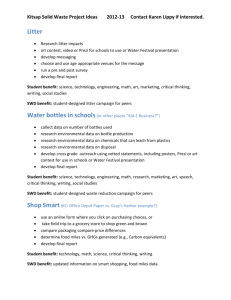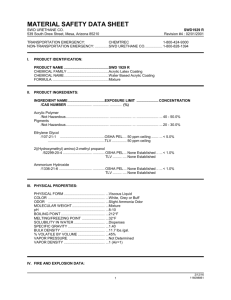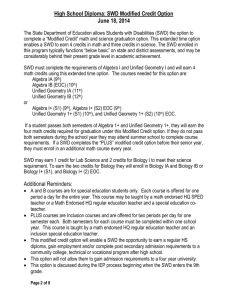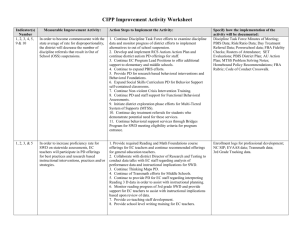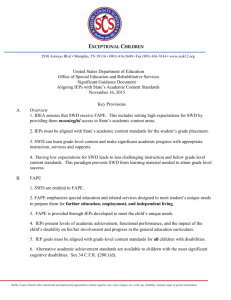Spotted Wing Drosophila Christelle Guédot, UW
advertisement
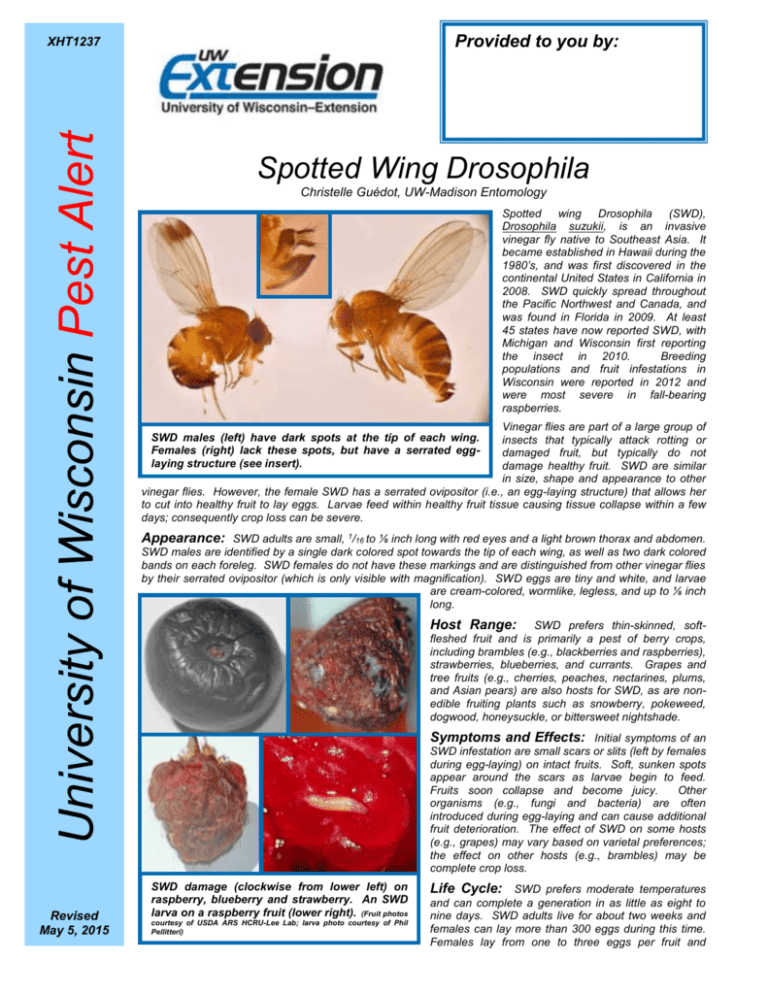
Provided to you by: University of Wisconsin Pest Alert XHT1237 Revised May 5, 2015 Spotted Wing Drosophila Christelle Guédot, UW-Madison Entomology Spotted wing Drosophila (SWD), Drosophila suzukii, is an invasive vinegar fly native to Southeast Asia. It became established in Hawaii during the 1980’s, and was first discovered in the continental United States in California in 2008. SWD quickly spread throughout the Pacific Northwest and Canada, and was found in Florida in 2009. At least 45 states have now reported SWD, with Michigan and Wisconsin first reporting the insect in 2010. Breeding populations and fruit infestations in Wisconsin were reported in 2012 and were most severe in fall-bearing raspberries. Vinegar flies are part of a large group of insects that typically attack rotting or damaged fruit, but typically do not damage healthy fruit. SWD are similar in size, shape and appearance to other vinegar flies. However, the female SWD has a serrated ovipositor (i.e., an egg-laying structure) that allows her to cut into healthy fruit to lay eggs. Larvae feed within healthy fruit tissue causing tissue collapse within a few days; consequently crop loss can be severe. SWD males (left) have dark spots at the tip of each wing. Females (right) lack these spots, but have a serrated egglaying structure (see insert). Appearance: SWD adults are small, 1/16 to ⅛ inch long with red eyes and a light brown thorax and abdomen. SWD males are identified by a single dark colored spot towards the tip of each wing, as well as two dark colored bands on each foreleg. SWD females do not have these markings and are distinguished from other vinegar flies by their serrated ovipositor (which is only visible with magnification). SWD eggs are tiny and white, and larvae are cream-colored, wormlike, legless, and up to ⅛ inch long. Host Range: SWD prefers thin-skinned, softfleshed fruit and is primarily a pest of berry crops, including brambles (e.g., blackberries and raspberries), strawberries, blueberries, and currants. Grapes and tree fruits (e.g., cherries, peaches, nectarines, plums, and Asian pears) are also hosts for SWD, as are nonedible fruiting plants such as snowberry, pokeweed, dogwood, honeysuckle, or bittersweet nightshade. Symptoms and Effects: Initial symptoms of an SWD infestation are small scars or slits (left by females during egg-laying) on intact fruits. Soft, sunken spots appear around the scars as larvae begin to feed. Fruits soon collapse and become juicy. Other organisms (e.g., fungi and bacteria) are often introduced during egg-laying and can cause additional fruit deterioration. The effect of SWD on some hosts (e.g., grapes) may vary based on varietal preferences; the effect on other hosts (e.g., brambles) may be complete crop loss. SWD damage (clockwise from lower left) on raspberry, blueberry and strawberry. An SWD larva on a raspberry fruit (lower right). (Fruit photos courtesy of USDA ARS HCRU-Lee Lab; larva photo courtesy of Phil Pellitteri) Life Cycle: SWD prefers moderate temperatures and can complete a generation in as little as eight to nine days. SWD adults live for about two weeks and females can lay more than 300 eggs during this time. Females lay from one to three eggs per fruit and University of Wisconsin Pest Alert several females can lay eggs in a single fruit. Eggs hatch in as little as one to three days. Larvae can complete feeding within several days (the exact length of time depends on temperature) and can pupate in the damaged fruit or in the top layers of leaf litter around infested plants. Because of their short generation time, large SWD populations can build up, especially if the insect is left uncontrolled. Monitoring: The first and most important step in SWD management is to determine whether SWD is present. Use trapping of adult flies for early SWD detection and to monitor trends in adult populations. Start monitoring when fruits begin to ripen and until harvest is completed. You can buy commercially available traps, or make simple, inexpensive traps using a 32 ounce clear plastic container with a lid. To allow SWD adults to enter the trap, drill or melt ten 3/16 inch diameter holes around the top of the cup. Bait traps with one tablespoon active dry yeast and four tablespoons sugar in twelve ounces of water. Alternatively (although less effective), you can use a two inch layer of apple cider vinegar in the bottom of the container. Add one to two drops of unscented dish soap to the trap to break the surface tension of the liquid so that flies are more likely to drown. Hang traps in a shaded plant canopy where fruit is present. For strawberries, place traps on the ground. Check traps and replace liquid bait weekly, using a hand lens to identify trapped insects. Be careful not to pour bait on the ground near the traps as this will confuse SWD adults and reduce the effectiveness of the traps. If you suspect fruit are infested with SWD, use a fruit dunk flotation method to look for SWD larvae. Place a random sample of fruit in a sealed plastic bag or glass dish and crush the fruit lightly to break the skin. Add a mixture of ¼ cup of salt in four cups of water and let the fruit, salt and water mixture stand for one hour. Look for larvae that float in the liquid. Backlight the bag or dish to help with detection. Control: Remove hosts such as wild blackberries, wild raspberries, wild plums, and wild grapes, which can serve as a Homeade SWD traps are easy to make reservoir for SWD. When growing fruit crops that are preferred from a 32 ounce clear plastic container hosts for SWD, be sure to harvest fruit promptly, and remove with a lid. and destroy overripe or infested fruit to help minimize the buildup of SWD. Exclusion netting with a fine mesh or row covers can be used prior to fruit ripening to keep SWD away from fruit. Use traps (as described above) to monitor for the presence of SWD adults. As needed, use broad-spectrum insecticides for control. Products containing carbamates, organophosphates, pyrethroids and spinosyns are available for use in conventional production. Spinosad and pyrethrum are available for use in organic production. Neonicotinoids are not effective against SWD and should not be used. Be sure to choose a product labeled for use on the specific fruit crop that you are growing and make sure to follow all label instructions to ensure that you use the product in the safest, most effective manner possible. Spray thoroughly in the plant canopy to kill adults before they are able to lay eggs in the fruit. Because you are applying insecticides to an edible crop, be especially aware of any preharvest interval (PHI) restrictions of the product that you select. For more information on spotted wing Drosophila: Visit the SWD website at http://labs.russell.wisc.edu/swd/ or contact your county Extension agent. 2015 by the Board of Regents of the University of Wisconsin System doing business as the division of Cooperative Extension of the University of Wisconsin Extension. An EEO/Affirmative Action employer, University of Wisconsin Extension provides equal opportunities in employment and programming, including Title IX and ADA requirements. This document can be provided in an alternative format by calling Brian Hudelson at (608) 262-2863 (711 for Wisconsin Relay). References to pesticide products in this publication are for your convenience and are not an endorsement or criticism of one product over similar products. You are responsible for using pesticides according to the manufacturer’s current label directions. Follow directions exactly to protect the environment and people from pesticide exposure. Failure to do so violates the law. Thanks to Amaya Atucha, Heidi Doering and Bryan Jensen for reviewing this document. A complete inventory of University of Wisconsin Garden Facts is available at the University of Wisconsin-Extension Horticulture website: http://hort.uwex.edu.


